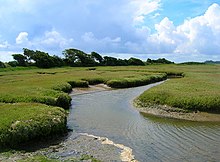Pagham Harbour
| Site of Special Scientific Interest | |
 | |
| Location | West Sussex |
|---|---|
| Grid reference | SZ 872 968[1] |
| Interest | Biological Geological |
| Area | 629.0 hectares (1,554 acres)[1] |
| Notification | 1986[1] |
| Location map | Magic Map |
Pagham Harbour is a 629-hectare (1,550-acre) biological and geological Site of Special Scientific Interest on the western outskirts of Bognor Regis in West Sussex.[1][2] It is a Geological Conservation Review site,[3] a Nature Conservation Review site,[1] a Ramsar site,[4] a Special Protection Area[5] and a Marine Conservation Zone.[6] An area of 599.1 hectares (1,480 acres) is a Local Nature Reserve.[7][8]
The harbour forms an area of saltmarsh and shallow lagoons. It is not an estuary, as no major streams enter the harbour with the only freshwater inflow a few small streams draining surrounding fields.[9][10]
History
In earlier times Pagham Harbour was a working harbour with three ports. One port was situated at the western end, of the harbour near Sidlesham Mill[a], and was known as Wardur. The port of Charlton was at the entrance to the harbour and the third was on the Pagham side of the harbour and was known as the Port of Wythering (Wyderinges).[12][13]
The port of Wardur was part of 'New Haven' a development in the Middle Ages.[11] The Port of Wythering was overrun by the sea in the 13th century and the whole harbour eventually silted up and ceased to be navigable, except for small craft.[14]
An attempt was made to drain the harbour for farming in c. 1873 with an embankment constructed across the edge of the lagoon to hold back the sea; this failed during a storm in December 1910 and was not reconstructed.[15][16][9]
At present the entrance to the sea is 50 metres wide.[17]
Notes
References
- ^ a b c d e "Designated Sites View: Pagham Harbour". Sites of Special Scientific Interest. Natural England. Retrieved 6 May 2019.
- ^ "Map of Pagham Harbour". Sites of Special Scientific Interest. Natural England. Retrieved 6 May 2019.
- ^ "Pagham Harbour (Coastal Geomorphology of England)". Geological Conservation Review. Joint Nature Conservation Committee. Retrieved 6 April 2019.
- ^ "Designated Sites View: Pagham Harbour". Ramsar Site. Natural England. Retrieved 6 April 2019.
- ^ "Designated Sites View: Pagham Harbour". Special Protection Areas. Natural England. Retrieved 6 April 2019.
- ^ "Pagham Harbour Marine Conservation Zone" (PDF). Department for Environment Food and Rural Affairs November 2013. Retrieved 13 October 2018.
- ^ "Pagham Harbour". Local Nature Reserves. Natural England.
- ^ "Map of Pagham Harbour". Local Nature Reserves. Natural England.
- ^ a b "Changes of Pagham Harbour". University of Sussex. Retrieved 3 November 2016.
- ^ Michael Shrubb (24 July 2003). Birds, Scythes and Combines: A History of Birds and Agricultural Change. Cambridge University Press. pp. 148–9. ISBN 978-0-521-81463-8.
- ^ a b Salzman, L.F. (1953). Sidlesham. A History of the County of Sussex. Vol. 4. pp. 210–215. Retrieved 27 November 2019.
- ^ Salzman, L.F. (1935). The City of Chichester: The port. A History of the County of Sussex. Vol. 3. pp. 100–102. Retrieved 27 November 2019..
- ^ Salzman, L.F. (1953). Selsey. A History of the County of Sussex. Vol. 4. pp. 205–210. Retrieved 27 November 2019.
- ^ Salzman, L.F. (1953). Pagham. A History of the County of Sussex. Vol. 4. pp. 227–333. Retrieved 27 November 2019.
- ^ A.J Prater (30 November 2010). Estuary Birds of Britain and Ireland. Bloomsbury Publishing. p. 192. ISBN 978-1-4081-3847-2.
- ^ Cundy, A.B.; Long, A.J.; Hill, C.T.; Spencer, C.; Croudace, I.W. (August 2002). "Sedimentary response of Pagham Harbour, southern England to barrier breaching in AD 1910". Geomorphology. 46 (3–4): 163–176. doi:10.1016/S0169-555X(02)00060-0.
- ^ May, V.J. "Pagham Harbour" (PDF). Geographical Conservation Review. DEFRA. Retrieved 3 November 2016.
External links
- West Sussex County Council - Pagham Harbour
- Special Protection Area designation
- Pagham Harbour photos and information
